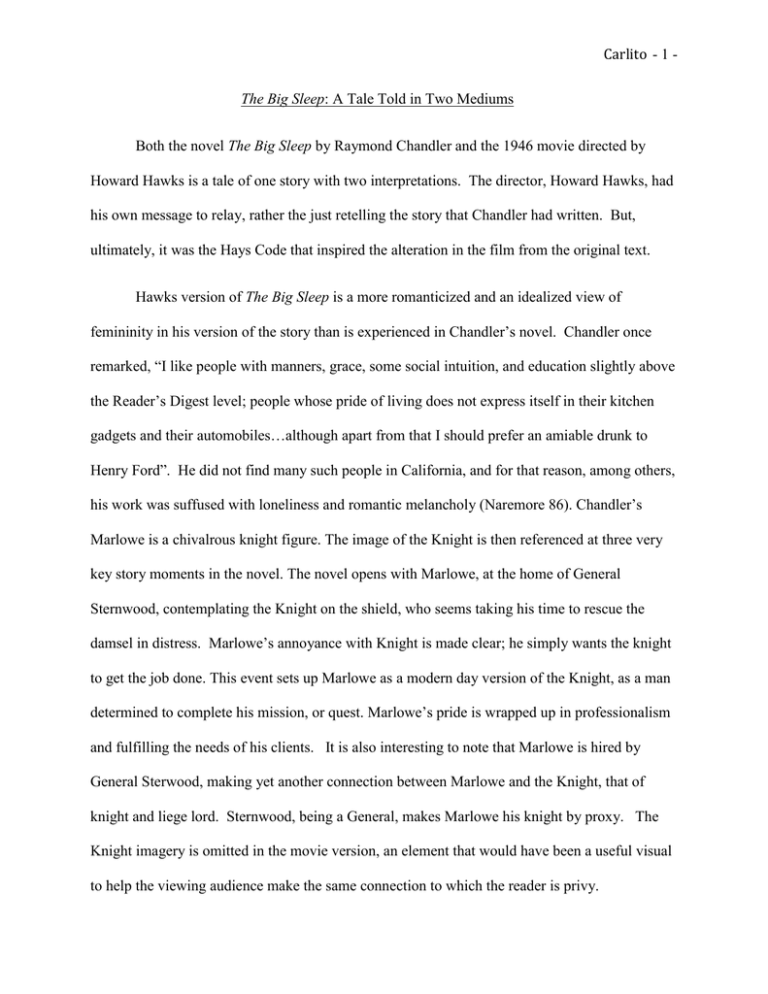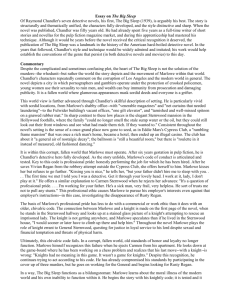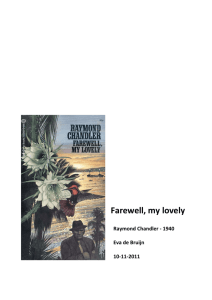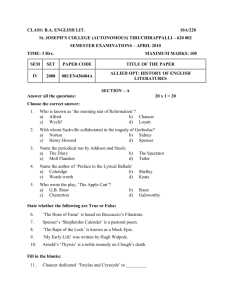
Carlito - 1 The Big Sleep: A Tale Told in Two Mediums
Both the novel The Big Sleep by Raymond Chandler and the 1946 movie directed by
Howard Hawks is a tale of one story with two interpretations. The director, Howard Hawks, had
his own message to relay, rather the just retelling the story that Chandler had written. But,
ultimately, it was the Hays Code that inspired the alteration in the film from the original text.
Hawks version of The Big Sleep is a more romanticized and an idealized view of
femininity in his version of the story than is experienced in Chandler’s novel. Chandler once
remarked, “I like people with manners, grace, some social intuition, and education slightly above
the Reader’s Digest level; people whose pride of living does not express itself in their kitchen
gadgets and their automobiles…although apart from that I should prefer an amiable drunk to
Henry Ford”. He did not find many such people in California, and for that reason, among others,
his work was suffused with loneliness and romantic melancholy (Naremore 86). Chandler’s
Marlowe is a chivalrous knight figure. The image of the Knight is then referenced at three very
key story moments in the novel. The novel opens with Marlowe, at the home of General
Sternwood, contemplating the Knight on the shield, who seems taking his time to rescue the
damsel in distress. Marlowe’s annoyance with Knight is made clear; he simply wants the knight
to get the job done. This event sets up Marlowe as a modern day version of the Knight, as a man
determined to complete his mission, or quest. Marlowe’s pride is wrapped up in professionalism
and fulfilling the needs of his clients. It is also interesting to note that Marlowe is hired by
General Sterwood, making yet another connection between Marlowe and the Knight, that of
knight and liege lord. Sternwood, being a General, makes Marlowe his knight by proxy. The
Knight imagery is omitted in the movie version, an element that would have been a useful visual
to help the viewing audience make the same connection to which the reader is privy.
Carlito - 2 Marlowe, in the novel as well as the movie, lives by a code of conduct in which he is
willing to operate. The trouble for Marlowe is that he is a member of a society that no longer
honors this outdated “chivalrous” code. This plays into another key scene form the novel that
was not in the movie. As Carmen lays naked in Marlowe’s bed, after he has rejected her, he
moves to the chess board where he is playing a solitary game of chess. Chandler’s Marlowe is a
true lone wolf who would rather enjoy the “battle” against his own self than to have to deal with
another person. Symbolically, Marlowe is battling his own intellect and emotions. Is he the
White Knight (Lancelot), or the Black Knight (Mordred)?
While Hawk’s version of Marlowe gives of the airs of being a solitary figure, in actuality,
he has friends. He himself refers to Sean Regan as “an old friend” which adds another layer as to
why Hawk’s Marlowe would be more inclined to stay on the case even after he was told his
services were no longer needed. He feels a duty to find out what happened to a man that he, on
some level, respects. Chandler’s Marlowe continues with the case strictly because of his personal
code of ethics: not to quit once he has accepted a job. Marlowe comes to the realization that his
code is relic of the past with his move of the Knight, a move that will not allow him to advance
to a checkmate. This small action is the catalyst that that leads Marlowe to say, “Knights had no
meaning in this game. It wasn’t a game for Knights” (Chandler 122). He sees his limitations and
lack of power, yet, even with this knowledge, Marlowe continues his duty to General Sternwood,
even if along the way he might have helped to cover up a few murders and kept incriminating
information from the police. He has already gone this far into the game, he must see it to it’s
final conclusion.
The knight makes his final appearance at the conclusion of the book itself, “The main
hallway looked the same. The portrait over the mantel had the same hot black eyes and the
Carlito - 3 knight in the stained-glass window still wasn’t getting anywhere untying the naked damsel from
the tree” (Chandler 163), The Knight in the window is unchanged by the events that unfold
around him and still unable to save the naked woman who remains, always, just out of his reach.
This is parallel to the fact that, in the novel, Marlowe was not able to save Carmen who, as stated
above, shows up naked in his bed. Not that it was Marlowe’s goal or need was save the person,
Carmen, but what she represents as a metaphor for a society that has fallen into the clutches of
corruption and despair. Carmen is the vehicle that sets this case in motion with threats of
blackmail to her father from her illicit photos, the very events that lead Marlowe on this case in
the first place.
Marlowe, by the end of the novel, is disillusioned with the modern world and his inability
to be a functioning member in a decaying society. Marlowe starts the novel with his moral code.
It is tested. It fails. Marlowe’s closing comments on the death, while bleak, hold a dark, poetic
beauty that sum up the view that Marlowe has of life on this earthly plane, “What did it matter
where you lay once you were dead? In a dirty sump or in a marble tower on top of a high hill?
You were dead, you were sleeping the big sleep, you were not bothered by things like that,”
(Chandler 179). Marlowe’s words bespeak a man tired of his struggles, of his own loss of a
moral code, who starts to believe that death, and what the afterlife holds, might be a more
enjoyable option than what is available to Marlowe here on earth.
Echoing the metaphor of the fallen Knight is that of the fallen world, the loss of an Eden,
represented by the shining realm of Los Angeles. Both Chandlers’ and Hawk’s Marlowe inhabit
a Los Angles filled with dark shadows and seedy streets that are masked by palm trees and
sunshine. “This experience, moreover, was always tinged with a deliciously Baudelarian
atmosphere of decadence, corruption, and decay; hence a novel like The Big Sleep sometimes
Carlito - 4 recalls T.S. Eliot’s darkest, most reactionary visions of London. Everywhere Marlowe looks, he
sees Jews, homosexuals, gangsters and various pretenders or arrivistes from the Midwest”
(Naremore 85). Noir literature and film was primarily centered in, or around, the city of Los
Angeles, the City of the Angeles. Perhaps a dubious honor all the same as the Los Angeles of
Noir tradition was filled with devils, demons, and fallen angels. The fact that even in the
nineteen-twenties and nineteen-thirties, Los Angeles still held a lawlessness that caused people
to see it as dingy outpost held over from the frontier.
Chandler’s version can be seen as a blasting of the Hollywood Elite and the excess of
their lifestyles. Chandler is quoted as saying, “Thus when he came to work in Hollywood, he
immediately commented upon ‘the strange psychological and spiritual kinship between the
operations of big money and the rackets,’ and he noted that the studio system was designed to
‘destroy the link between the writer and his subconscious’” (Naremore 86). Hawkin’s movie
version is a more forgiving tale about the underbelly that permeated Los Angles. There are
gangsters and women with loose moral ethics, but the Los Angeles Police Department are
presented as pillars of the community.
Bernie Ohls, the D.A.’s chief investigator, is played as a long time friend of Marlowe,
again disputing Marlowe’s “lone-wolf” existence and showing Los Angles to be a place where
tough men make tough choices for the greater good. Berniek, knowing the kind of man Marlowe
is, tells Marlowe, as the body of the Sternwood Chauffer, Owen Taylor, is being fished out of the
pier, “It’s not how you would have done it” indicating that Ohls knows Marlowe is innocent, in
spite of the evidence and Ohls will act accordingly. This added line to movie, that is not in the
novel, gives the Ohls character a moral center in which to operate, while Marlowe, as private
detective, is more of a rogue cowboy out in the frontier, seeking bad guys, and thus playing into
Carlito - 5 the motif of Los Angeles as a frontier town with rules onto itself. He is still outside the structure
of the law. As an honest law-abiding officer, it is Ohls duty to question Marlowe even if he know
that Marlowe is not the culprit. The novel shows the smarmy side of corruption in the police
department, merely masked with a false show of respectability, just as the movies themselves
show an artificial reality. The movie puts forth an idealized fairy tale world in which evil exists,
but good always triumphs. This contrasting metaphor can be expanded to Chandler’s and Hawk’s
personal views as well, and thus their interpretation of the novel and the film respectively.
Another contributing factor to the differences in story between the film version of The
Big Sleep and the novel had to do with the implementation of the Hays Code (also known as the
Production Code) in nineteen-thirty-four by the Motion Pictures Producers and Distributors
Association. Under the leadership of Joseph Breen, the new codes made new headaches for
studios and filmmakers who, up to this point, had not had to answer to anyone on the content that
was presented in the films they produced. The new production code Administration could edit or
censor any script they felt fell within the parameters of violating the code. Film Noir and the
hard-boiled fiction from which many of Noir’s plots derive, were a ready target for the Hays
Codes. With Noir’s dark themes of corruption of authority figures, anti-heroes and morally
corrupt women, the films that made it though the process scarcely resembled the novels that gave
birth to them.
One can argue that, while the film The Big Sleep shares many of the same scenes and
dialogue with the original text, it is in many ways a shell of the novel Chandler wrote in terms of
tone, plot, and character development. Many of the changes that affected the tonally of the film
had to do with censoring by the Hays Code. The Big Sleep was a victim of the Hays Codes
“editing”, so much so that between the censorship of the Breen’s office and the “romanticizing”
Carlito - 6 of Marlowe and Vivian the movie bears little resemblance to the novel. Due to the success of the
pairing of Humphrey Bogart (Marlowe) and Lauren Bacall (Vivian Rutledge) in Hawk’s
previous production of Hemingway’s To Have and Have Not, the studio and Hawks were keen to
play off the publicity of the pairing by building more romance in The Big Sleep to sell the film to
the general public. This prompted Hawks to add full scenes of new material that were not in the
original text. The finished product is a cryptic tale that leaves the viewer wondering who the real
killer was, what ever happened to Sean Reagan, and why did Carol Lundgren kill Joe Brody?
The Hays Code stated, “The sanctity of the institution of marriage and the home shall be
upheld. Pictures shall not infer that low forms of sex relationships are accepted or a common
thing” (Bynum 2006). Nor were they allowed to show, or mention, homosexuality. As
Naremore states, “…the censorship reports of the period reveal that classic Noir was almost
obsessed with sexual perversity. The villains in these pictures tend to be homosexuals aesthetes
(The Maltese Falcon) or homosexual Nazi sadists (Brute Force) who threaten the values of a
democratic and somewhat proletarian masculinity” (99). Homosexuality, at the time, was
considered a mental illness that went against social and moral decorum. In fact, it was listed as
one by the American Psychiatric Association until 1973. Needless to say, these restrictions on
screenwriter made adapting a Noir novel problematic at best, even when the screenwriter had the
input of the author of the novel. Such was the case with The Big Sleep. The rampantly sexual,
openly gay characters, and corruptible police departments in the novel had to be erased from the
screenplay. William Faulkner, Leigh Brackett, and Jules Furthman were thereby left in a Noir
world of Chandler’s making that was void of the morally corrupt issues Chandler was
spotlighting in the first place.
Carlito - 7 Some of the sexual subject matter was easier to write into the screen adaptation, in the
form of innuendo filled conversations and small, suggestive moments of sexual chemistry
between Marlowe and Vivian. For example, in the scene whereupon entering his office,
Marlowe finds Vivian waiting for him. After they exchange barbs, she sits on his desk trying to
nonchalantly scratch an itch on her leg in a “lady like” manner, until Marlowe tells her, “Go
ahead and scratch”. This scene works on two levels. To work the sexual contexts into the film,
it allows a reason for Vivian to “expose” her thigh to Marlowe, and the innuendo of the sexual
desire the two characters have for each other to be discussed in terms of a physical “itch” that
Marlowe acknowledges and encourages Vivian to satisfy by “scratching”, a not-so-subtle
metaphor for a sexual invitation. This concept of sexual innuendo in also expressed in the fact
that every female in the film falls “in lust” with Marlowe, in one form or another, emphasizing
his sexual prowess and appeal, so readily manifest in the novel, despite the dearth of feminine
attention there. Referencing the film again, the scene where Marlowe is tailing Geiger in a taxi
cab the male driver is replaced with a beautiful female driver who, after dropping Marlowe off in
front of Joe Brody apartment, hands Marlowe a business card and states that if he needs “ride”
again to giver her a call, but nights are better as she is off nights, again using minimally subtle
verbal foreplay to emphasize Marlowe’s masculinity and get around the Hay Code rules.
It is interesting to note the character of Marlowe in the novel would not feel entirely
comfortable with sexual attentions of so many females being directed at him. In the novel, the
only female he thinks about in romantic context is that of Mona Mars, the wife of the gangster
Eddie Mars, his main antagonist in the novel. Mona Mars is a woman who is completely
unattainable and therefore safe to harbor sexual desire for her as nothing need ever be done about
it. Vivian and Carman willingly offer themselves to Marlowe but they are not tied down to
Carlito - 8 another man, so attachment is a possibility, especially with the character of Vivian, whom
Marlowe has chemistry with on screen as well as the page. Carmen is too much of a loose
cannon, in both novel and the film, to be a serious romantic contender. The screenwriters
combined the characters of Vivian and Mona, from the novel, into the composite character of
Vivian Rutledge in the film, as powerhouse of class and va-va-voom. In the film, the
screenwriters place Vivian at the Mars’ hide-out, where Mona Mars is hiding in the final climax
of the film, when she was not even aware of Mona being dead or alive in the novel. The only
romantic moment that Marlowe of the novel has is when he pushes himself onto Mona and
demands a kiss, which she icily gives, and then helps him to escape and take on Canino. In the
film, Hawks gives these moments to Vivian, leaving no doubt in the viewers mind that Marlowe
and Vivian will have their Hollywood “happily ever after”. Chandler’s Marlowe is guaranteed
the complete opposite “happily ever after”, to keep his lone wolf status in check and presents the
reader with a significantly darker outcome.
The crucial story elements that deal with homosexuality had to be completely cut out of
the screenplay to meet the Hays Code standards, and unlike the sexual aspects of the plot, which
could still in many way be implied, the loss of Geiger as a homosexual male affects the film in
the most obvious and negative way. The narrative becomes muddled due to the fact that we
never have motive as to why Carol Lundgrun would kill Joe Brody in retaliation for the death of
the much older Geiger. The lack of motivation for two of the killings (Geiger and Brody) are
where the murder mystery elements of the film start to disintegrate, and both circle around the
character of Geiger who, being the most “morally corrupt” character in the novel (he is gay and
operates a pornography ring), had to censored due to the Hays Code. The chain of murders never
adds up to a satisfying conclusion because we can’t know the purpose behind the murders.
Carlito - 9 Carmen’s killing of Rusty Regan (Sean Regan in the film) is also omitted from the film due to
the sexual and drug-induced motives for which she commits the crime. The result being that, in
the film, we are left with another unsolved murder that adds to the muddiness of the plot.
It is clear that the censorship of the Hays Code, as well as Howard Hawk’s need to put
his vision on the adaptation of Raymond Chandler novel, played a vital role in the nineteenforty-six movie The Big Sleep. The Hays Code limited many story aspects that were significant
to the plot, making it almost impossible to follow a cohesive narrative with a satisfying ending.
Hawk’s creative changes make the film less male-oriented, and Los Angeles is a not as much a
dark and despairing place as presented in the novel. The Big Sleep presents all the archetypes of
Noir in much lighter and idealized package in the end. Nevertheless, The Big Sleep is equally
effective on the screen as on the page, though differently so.
Carlito- 10 Works Cited
1. Chandler, Raymond. The Big Sleep. London: Thinking Ink Media . 2011. Print.
2. Silver, Alain and Ursini. Film Noir Reader. New Jersey: Limelight Editions, 1996. Print.
3. Naremore, James. More Than Night: Film Noir in its Contexts. Updated and Expanded
Ed. Berleley: University of California Press, 2008. Print
4. Bynum, M. (2006) The Motion Picture Production Code of the 1930s (Hays Code)
(Accessed Dec, 2012)
[. (2006) The Motion Picture Production Code of 1930 ( num, M. (2006)
The Motion Picture Production Code of 1930 (Hays Code) <







